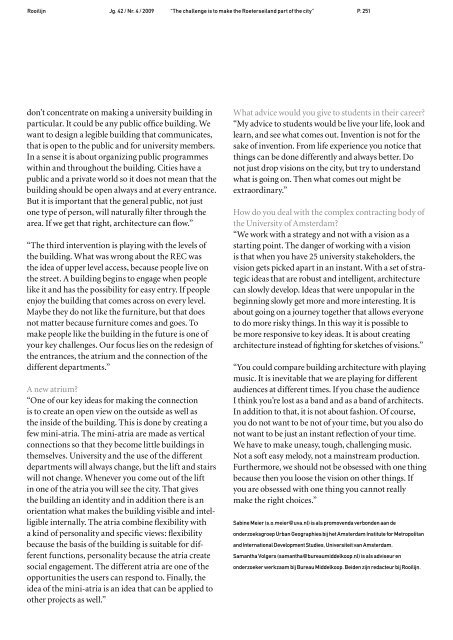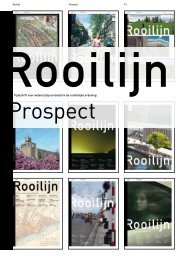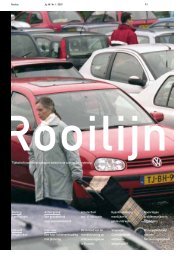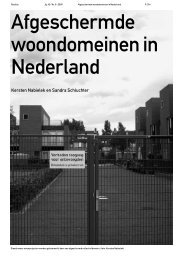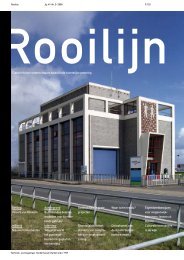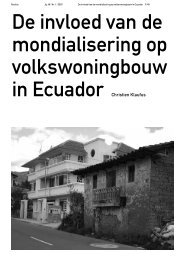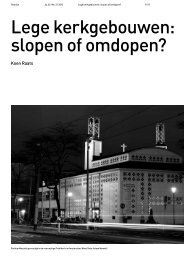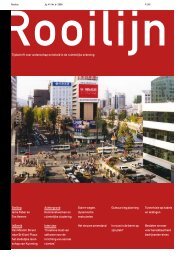De campus als publiek domein - Rooilijn
De campus als publiek domein - Rooilijn
De campus als publiek domein - Rooilijn
Create successful ePaper yourself
Turn your PDF publications into a flip-book with our unique Google optimized e-Paper software.
<strong>Rooilijn</strong><br />
Jg. 42 / Nr. 4 / 2009<br />
don’t concentrate on making a university building in<br />
particular. It could be any public office building. We<br />
want to design a legible building that communicates,<br />
that is open to the public and for university members.<br />
In a sense it is about organizing public programmes<br />
within and throughout the building. Cities have a<br />
public and a private world so it does not mean that the<br />
building should be open always and at every entrance.<br />
But it is important that the general public, not just<br />
one type of person, will naturally filter through the<br />
area. If we get that right, architecture can flow.”<br />
“The third intervention is playing with the levels of<br />
the building. What was wrong about the REC was<br />
the idea of upper level access, because people live on<br />
the street. A building begins to engage when people<br />
like it and has the possibility for easy entry. If people<br />
enjoy the building that comes across on every level.<br />
Maybe they do not like the furniture, but that does<br />
not matter because furniture comes and goes. To<br />
make people like the building in the future is one of<br />
your key challenges. Our focus lies on the redesign of<br />
the entrances, the atrium and the connection of the<br />
different departments.”<br />
A new atrium?<br />
“One of our key ideas for making the connection<br />
is to create an open view on the outside as well as<br />
the inside of the building. This is done by creating a<br />
few mini-atria. The mini-atria are made as vertical<br />
connections so that they become little buildings in<br />
themselves. University and the use of the different<br />
departments will always change, but the lift and stairs<br />
will not change. Whenever you come out of the lift<br />
in one of the atria you will see the city. That gives<br />
the building an identity and in addition there is an<br />
orientation what makes the building visible and intelligible<br />
internally. The atria combine flexibility with<br />
a kind of personality and specific views: flexibility<br />
because the basis of the building is suitable for different<br />
functions, personality because the atria create<br />
social engagement. The different atria are one of the<br />
opportunities the users can respond to. Finally, the<br />
idea of the mini-atria is an idea that can be applied to<br />
other projects as well.”<br />
“The challenge is to make the Roeterseiland part of the city”<br />
P. 251<br />
What advice would you give to students in their career?<br />
“My advice to students would be live your life, look and<br />
learn, and see what comes out. Invention is not for the<br />
sake of invention. From life experience you notice that<br />
things can be done differently and always better. Do<br />
not just drop visions on the city, but try to understand<br />
what is going on. Then what comes out might be<br />
extraordinary.”<br />
How do you deal with the complex contracting body of<br />
the University of Amsterdam?<br />
“We work with a strategy and not with a vision as a<br />
starting point. The danger of working with a vision<br />
is that when you have 25 university stakeholders, the<br />
vision gets picked apart in an instant. With a set of strategic<br />
ideas that are robust and intelligent, architecture<br />
can slowly develop. Ideas that were unpopular in the<br />
beginning slowly get more and more interesting. It is<br />
about going on a journey together that allows everyone<br />
to do more risky things. In this way it is possible to<br />
be more responsive to key ideas. It is about creating<br />
architecture instead of fighting for sketches of visions.”<br />
“You could compare building architecture with playing<br />
music. It is inevitable that we are playing for different<br />
audiences at different times. If you chase the audience<br />
I think you’re lost as a band and as a band of architects.<br />
In addition to that, it is not about fashion. Of course,<br />
you do not want to be not of your time, but you <strong>als</strong>o do<br />
not want to be just an instant reflection of your time.<br />
We have to make uneasy, tough, challenging music.<br />
Not a soft easy melody, not a mainstream production.<br />
Furthermore, we should not be obsessed with one thing<br />
because then you loose the vision on other things. If<br />
you are obsessed with one thing you cannot really<br />
make the right choices.”<br />
Sabine Meier (s.o.meier@uva.nl) is <strong>als</strong> promovenda verbonden aan de<br />
onderzoeksgroep Urban Geographies bij het Amsterdam Institute for Metropolitan<br />
and International <strong>De</strong>velopment Studies, Universiteit van Amsterdam.<br />
Samantha Volgers (samantha@bureaumiddelkoop.nl) is <strong>als</strong> adviseur en<br />
onderzoeker werkzaam bij Bureau Middelkoop. Beiden zijn redacteur bij <strong>Rooilijn</strong>.


